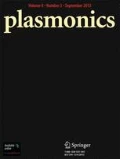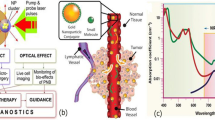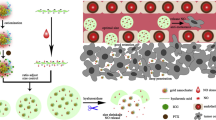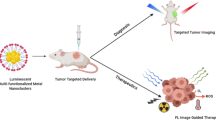Abstract
Because of their photo-optical distinctiveness and biocompatibility, gold nanoparticles have proven to be powerful tools in various nanomedical applications. In this article, we discuss the advantage of gold nanoparticles in image diagnostic application of melanoma. It has demonstrated the potential role of gold nanoparticles in the study of tumour tissue architecture and the utility of gold nanoparticles in the hystopathological exam of B16 melanoma with the benefit of fluorescence emission of gold nanoparticles in UV spectrum. The optical properties of colloidal gold nanoparticles allow spectroscopic detection and identification of melanoma cells. The method proposed is easy, inexpensive and reliable for hystopathological analysis of melanoma. The fluorescence images in the cryosections of tissues depicted a strong luminescence property of gold nanoparticles uptaken in melanoma, results that confirm the role of the gold nanoparticles in biological labelling and imaging applications. To emphasize the AuNPs influence over the biological tissues, a study of the chemical bonds configuration was performed using Raman spectrometry.






Similar content being viewed by others
References
Mie G (1908) Beitrage zur Optik Truber Medien, Speziell Kolloidaler Metallosungen. Ann Phys 25:377–445
Astruc D (2008) Nanoparticles and catalysis. In: Astruc D (ed) Transition-metal nanoparticles in catalysis. Wiley-VCH, New York, pp 1–48
Zhang D-F, Zhang Q, Niu L-Y, Jiang L, Yin P-G, Guo L (2011) Self-assembly of gold nanoparticles into chain-like structures and their optical properties. J Nanopart Res. doi:10.1007/s11051-011-0312-4
Le R, Eric C, Etchegoin PG (2009) Principles of surface-enhanced Raman spectroscopy and related plasmonic effects. Elsevier, Amsterdam, pp 318–342
Alvarez MM, Khoury JT, Schaaff TG, Sha MN, Vezmar I, Whetten RL (1997) Optical absorption spectra of nanocrystal gold molecules. J Phys Chem B 101:3713–3719
Zharov VP, Galanzha EI, Tuchin VV (2006) In vivo photothermal flow cytometry: imaging and detection of individual cells in blood and lymph flow. J Cell Biochem 97:916–932
Daniel MC, Astruc D (2004) Gold nanoparticles assembly, supramolecular chemistry, quantum-size-related properties, and applications toward biology, catalysis, and nanotechnology. Chem Rev 104:293–346
De Dror S, Challener W (2010) Modern introduction to surface plasmons: theory, mathematica modelling and applications. Cambridge University Press, Cambridge, pp 95–120
Leostean C, Pana O, Turcu R, Soran ML, Macavei S, Chauvet O, Payen C (2011) Comparative study of core–shell iron/iron oxide gold covered magnetic nanoparticles obtained in different conditions. J Nanopart Res. doi:10.1007/s11051-011-0313-3
Gareau DS, Merlino G, Corless C, Kulesz-Martin M, Jacques SL (2007) Noninvasive imaging of melanoma with reflectance mode confocal scanning laser microscopy in a murine model. J Investig Dermatol 127:2184–2190. doi:10.1038/sj.jid.5700829
Sandu T, Vrinceanu D, Georgiu E (2011) Surface plasmon resonances of clustered nanoparticles. Plasmonisc 6:407–412
James VJ, Kirby N (2010) The connection between the presence of melanoma and changes in fibre diffraction patterns. Cancers 2:1155–1165
Winston WT (2010) Malignant melanoma. http://emedicine.medscape.com/article/280245-overview
Tamer U, Ismail HB, Erhan T, Adem Z, Ilker D, Yalcın E (2011) Fabrication of magnetic gold nanorod particles for immunomagnetic separation and SERS application. J Nanopart Res. doi:10.1007/s11051-010-0213-y
Giljohann DA, Seferos DS, Patel PC, Millstone JE, Rosi NL, Mirkin CA (2007) Oligonucleotide loading determines cellular uptake of DNA-modified gold nanoparticles. Nano Lett 7:3818–3821
Chithrani BD, Ghazani AA, Chan WCW (2006) Determining the size and shape dependence of gold nanoparticle uptake into mammalian cells. Nano Lett 6:662–668
Chithrani BD, Chan WCW (2007) Elucidating the mechanism of cellar uptake and removal of protein-coated gold nanoparticles of different sizes and shapes. Nano Lett 7:1542–1550
Jiang W, Kim BYS, Rutka JT, Chan WCW (2008) Nanoparticle-mediated cellular response is size-dependent. Nature Nanotech 3:145–150
Guarnieri D, Guaccio A, Fusco S, Netti PA (2011) Effect of serum proteins on polystyrene nanoparticle uptake and intracellular trafficking in endothelial cells. J Nanopart Res. doi:10.1007/s11051-011-0375-2
Bhattacharya R, Patra CR, Verma R, Kumar S, Greipp PR, Mukherjee P (2007) Gold nanoparticles inhibit the proliferation of multiple myeloma cells. Adv Mater 19:711–716
Francis LS, Allan HH (2007) Avoid common pitfalls when using Henry's law. Chem Eng Prog 103:33–39
Acknowledgments
The authors wish to acknowledge the financial support from the European Social Fund through POSDRU/89/1.5/S/63700, 2010–2013, ‘Human Resource Development by Postdoctoral Research on Micro and Nanotechnologies’, and the Project No. 582/2009—PN II ‘Ideas’ Program, funded under PN II Program of the Romanian Ministry of Education, Research, Youth and Sport–National Authority for Scientific Research. The authors appreciate the help of PhD student Ana Maria Enciu from the National Institute for Research and Development in the Field of Pathology and Biomedical Sciences Victor Babeş, Bucharest, Romania and George Simion from the Department of Pathology of Emergency University Hospital, Bucharest, Romania. The work was carried out in collaboration with the Department of Molecular Biology from the National Institute Victor Babeş, Bucharest, Romania.
Author information
Authors and Affiliations
Corresponding author
Rights and permissions
About this article
Cite this article
Avram, M., Bălan, C.M., Petrescu, I. et al. Gold Nanoparticle Uptake by Tumour Cells of B16 Mouse Melanoma. Plasmonics 7, 717–724 (2012). https://doi.org/10.1007/s11468-012-9363-3
Received:
Accepted:
Published:
Issue Date:
DOI: https://doi.org/10.1007/s11468-012-9363-3




